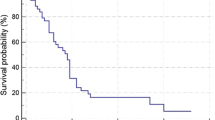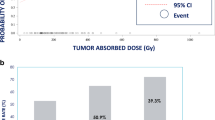Abstract
In Canada and Europe, yttrium-90 microspheres (TheraSphere®; MDS Nordion, Ottawa, Canada) are a primary treatment option for primary and secondary hepatic malignancies. We present data from 30 patients with hepatocellular carcinoma (HCC) and metastatic liver disease treated with TheraSphere from a single academic institution to evaluate the angiographically evident embolization that follows treatment. Seven interventional radiologists from one treatment center compared pretreatment and posttreatment angiograms. The reviewers were blinded to the timing of the studies. The incidence of postembolization syndrome (PES) was determined as well as objective tumor response rates by the World Health Organization (WHO), Response Evaluation Criteria in Solid Tumors (RECIST), and European Association for the Study of the Liver (EASL) criteria. There were 420 independent angiographic observations that were assessed using the chi-squared statistic. The pretreatment and posttreatment angiograms could not be correctly identified on average more than 43% of the time (p = 0.0004). The postprocedure arterial patency rate was 100%. The objective tumor response rates for all patients were 24%, 31%, and 72% for WHO, RECIST, and EASL criteria, respectively. All of the patients tolerated the procedure without complications and were treated on an outpatient basis, and four patients had evidence of PES. This treatment method does not result in macroscopic embolization of the hepatic arteries, thereby maintaining hepatic tissue perfusion. These data support the principle that the favorable response rates reported with TheraSphere are likely due to radiation and microscopic embolization rather than flow-related macroscopic embolization and ischemia.





Similar content being viewed by others
References
Isselbacher KJ, Braunwald E, Wilson JD, et al. (1993) Tumors of the liver. In: Braunwald E, Fauci AS, Kasper DL, Houser SL, Longo DL, Jameson JL (eds) Harrison’s Principles of Internal Medicine, 13th ed. New York: McGraw-Hill, pp 1495–1498
Cromheecke M, de Jong KP, Hoekstra HJ (1999) Current treatment for colorectal cancer metastatic to the liver. Eur J Surg Oncol 25:451–463
Sutcliffe R, Maguire D, Ramage J, et al. (2004) Management of neuroendocrine liver metastases. Am J Surg 187:39–46
Florman S, Toure B, Kim L, et al. (2004) Liver transplantation for neuroendocrine tumors. J Gastrointest Surg 8:208–212
Gupta S, Yao JC, Ahrar K, et al. (2003) Hepatic artery embolization and chemoembolization for treatment of patients with metastatic carcinoid tumors: the M.D. Anderson experience. Cancer J 9:261–267
Gee M, Soulen MC (2004) Chemoembolization for hepatic metastases. Tech Vasc Interv Radiol 5:132–140
Curley SA, Izzo F (2002) Radiofrequency ablation of primary and metastatic hepatic malignancies. Int J Clin Oncol 7:72–81
Hanna NN (2004) Radiofrequency ablation of primary and metastatic hepatic malignancies. Clin Colorectal Cancer 4:92–100
Hoffman AL, Wu SS, Obaid AK, et al. (2002) Histologic evaluation and treatment outcome after sequential radiofrequency ablation and hepatic resection for primary and metastatic tumors. Am Surg 68:1038–1043
Izzo F (2003) Other thermal ablation techniques: microwave and interstitial laser ablation of liver tumors. Ann Surg Oncol 10:491–497
Bhattacharya R, Rao S, Kowdley KV (2002) Liver involvement in patients with solid tumors of nonhepatic origin. Clin Liver Dis 6:1033–1043
Goin J, Dancey JE, Roberts C, et al. (2004) Comparison of post-embolization syndrome in the treatment of patients with unresectable hepatocellular carcinoma: Trans-catheter arterial chemo-embolization versus yttrium-90 glass microspheres. World J Nucl Med 3:49–56
Andrews JC, Walker SC, Ackermann RJ, et al. (1994) Hepatic radioembolization with yttrium-90 containing glass microspheres: Preliminary results and clinical follow-up. J Nucl Med 1994 35:1637–1644
Russell JL, Carden JL, Herron HL (1988) Dosimetry calculation for yttrium-90 used in the treatment of liver cancer. Endocuriether/Hyperthermia Oncol 4:171–186
Carr BI (2004) Hepatic arterial 90yttrium glass microspheres (TheraSphere) for unresectable hepatocellular carcinoma: Interim safety and survival data on 65 patients. Liver Transplant 10:S107–S110
MDS Nordion (2005) Yttrium-90 microspheres (TheraSphere) package insert. Ottawa, Canada: MDS Nodion
Dancey JE, Shepherd FA, Paul K, et al. (2000) Treatment of nonresectable hepatocellular carcinoma with intrahepatic 90Y-microspheres. J Nucl Med 41:1673–1681
Salem R, Thurston KG, Carr BI, et al. (2002) Yttrium-90 microspheres: radiation therapy for unresectable liver cancer. J Vasc Intervent Radiol 13:S223–S229
Llovet JM, Beaugrand M (2003) Heptaocellular carcinoma: Present status and future prospects. J Hepatol 38:S136–S149
Mazzaferro V, Battison C, Perrone S, et al. (2004) Radiofrequency ablation of small hepatocellular carcinoma in cirrhotic patients awaiting liver transplantation. Ann Surg 240:900–909
Llovet JM, Bruix J (2003) Systematic review of randomized trials for unresectable hepatocellular carcinoma: Chemoembolization improves survival. Hepatology 37:429–442
Geschwind J, Ramsey DE, van der Wal B, et al. (2003) Transcatheter arterial chemoembolization of liver tumors: effects of embolization protocol on injectable volume of chemotherapy and subsequent arterial patency. Cardiovasc Intervent Radiol 26:111–117
Van Hazel G, Blackwell A, Anderson J, et al. (2004) Randomised phase 2 trial of SIR-Spheres plus fluorouracil/leucovorin chemotherapy versus fluorouracil/leucovorin chemotherapy alone in advanced colorectal cancer. J Surg Oncol 88:78–85
Coldwell D, Kennedy A (2005) Treatment of hepatic metastases from breast cancer with Yttrium-90 SIR-Spheres radioembolization. Society of Interventional Radiology 2005 annual meeting, New Orleans, LA
Harrison L, Blackwell K (2005) Hypoxia and anemia: factors in decreased sensitivity to radiation therapy and chemotherapy? Oncologist 5(Suppl):S31–S40
Harrison LB, Chadha M, Hill RJ, et al. (2002) Impact of tumor hypoxia and anemia on radiation therapy outcomes. Oncologist 7:492–508
Harnois D, Steers J, Andrews J, et al. (1999) Preoperative hepatic artery chemoembolization followed by orthotopic liver transplantation for hepatocellular carcinoma. Liver Transplant Surg 5:192–199
Cheng YF, Huang TL, Chen TY, et al. (2005) Impact of preoperative transarterial embolization on the treatment of hepatocellular carcinoma with liver transplantation. World J Gastroenterol 11:1433–1438
Miller AB, Hoogstraten B, Staquet M, et al. (1981) Reporting results of cancer treatment. Cancer 47:207–214
Therasse P, Arbuck SG, Eisenhauer EA, et al. (2000) New guidlines to evaluate the response to treatment in solid tumors. J Natl Cancer Inst 92:205–216
James K, Eisenhauer E, Therasse P (1999) Measure once or twice: Does it really matter? J Natl Cancer Inst 91:1780–1781
Liu MD, Uaje MB, Al-Ghazi MS, et al. (2004) Use of yttrium-90 TheraSphere for the treatment of unresectable hepatocellular carcinoma. Am Surg 70:947–953
Geschwind JF, Salem R, Carr BI, et al. (2004) Yttrium-90 microspheres for the treatment of hepatocellular carcinoma. Gastroenterology 127(5 Suppl 1):S194–S205
Padhani AR, Ollivier L (2001) The RECIST criteria: Implications for diagnostic radiologists. Br J Rad 74:983–986
Bruix J, Sherman M, Llovet JM, et al. (2001) Clinical management of hepatocellular carcinoma. Conclusions of the Barcelona–2000 EASL conference. J Hepatol 35:421–430
Salem R, Lewandowski R, Roberts C, et al. (2004) Use of yttrium-90 glass microspheres (TheraSphere) for the treatment of unresectable hepatocellular carcinoma in patients with portal vein thrombosis. J Vasc Intervent Radiol 15:335–345
Goin JE, Salem R, Carr BI, et al. (2005) Treatment of unresectable hepatocellular carcinoma with intrahepatic yttrium 90 microspheres: factors associated with liver toxicities. J Vasc Intervent Radiol 16:205–213
Goin JE, Salem R, Carr BI, et al. (2005) Treatment of unresectable hepatocellular carcinoma with intrahepatic yttrium 90 microspheres: A risk-stratification analysis. J Vasc Intervent Radiol 16:195–203
Acknowledgments
We would like to acknowledge the generous assistance of Leslie Herr, Karen Barrett, Angi Courtney, Peggy Gilbertsen and Krystina Sajdak. This work was supported in part by MDS Nordion. RS is a consultant; RDH is an employee of MDS Pharma Services, a contract research organization and subsidiary of MDS Inc. None of the other authors have disclosed a potential conflict of interest.
Author information
Authors and Affiliations
Corresponding author
Rights and permissions
About this article
Cite this article
Sato, K., Lewandowski, R., Bui, J.T. et al. Treatment of Unresectable Primary and Metastatic Liver Cancer with Yttrium-90 Microspheres (TheraSphere®): Assessment of Hepatic Arterial Embolization. Cardiovasc Intervent Radiol 29, 522–529 (2006). https://doi.org/10.1007/s00270-005-0171-4
Published:
Issue Date:
DOI: https://doi.org/10.1007/s00270-005-0171-4




